The Best Stroke and Cerebrovascular Treatment in Andhra Pradesh

Dr. Rao’s Hospital is a leading Neurology and neurosurgery hospital for stroke and cerebrovascular treatment in Guntur, Andhra Pradesh. Here you are assured of the highest level of comprehensive care for stroke (paralysis) and other cerebrovascular disorders, including stroke IV tPA, mechanical thrombectomy (clot removal from the blood vessel of the brain through the stent-like device), ruptured and unruptured intracranial aneurysms, intracerebral hemorrhages, vascular malformations, carotid artery disease, and diseases of the brain requiring bypass surgery and looking for stroke and cerebrovascular treatment in Guntur and Andhra Pradesh? Look no further; Dr. Rao’s hospital is the best stroke and cerebrovascular center in Andhra Pradesh.
Dr. Mohana Rao Patibandla, the Founder of Dr. Rao’s Hospital, is a par excellence neurosurgeon and interventional neuro specialist. He is trained and experienced in all subspecialties of neurosciences and excels in functional neurosurgery, stereotactic radiosurgery, brain tumors, etc.
Dr. Rao’s Hospital is the only center in the region capable of specific treatments that can potentially reverse stroke if applied within hours of onset, so it is important to rush to Dr. Rao’s Hospital immediately after symptoms appear. Their acute stroke intervention team is on call 24 hours a day. You would be given IV tPA if you were in the hospital within 4.5 hours of the onset of the stroke or mechanical thrombectomy within 24 hours of onset for the large vessel strokes.
Now let’s understand what a stroke is?

A stroke is medically known as a cerebrovascular accident (CVA) and, in layman’s language, Paralysis. A stroke occurs when a blockage or a blood vessel rupture stops blood flow to a brain section. It would help if you were vigilant of the warning signs of a stroke. The warning symptoms are Face drooping, arms drooping or numbness, speech difficulty, eye deviation, and dizziness. If you suspect you or someone close to you is having a stroke, seek medical help immediately. The sooner you get care, the better because a stroke left untreated for too long can cause permanent brain damage.
Types of stroke

Strokes are of two types, ischemic and haemorrhagic. A blockage causes an ischemic stroke, whereas a blood vessel rupture causes a hemorrhagic stroke. Both forms of stroke deprive a section of the brain of blood and oxygen, resulting in the death of brain cells.
Ischemic stroke
85% of all strokes are ischemic, which occurs when a blood clot blocks a blood artery, preventing blood and oxygen from reaching a portion of the brain. It can happen in one of two ways.
An embolic stroke occurs when a blood clot forms elsewhere in the body and gets lodged in a blood vessel in the brain. On the other hand, a thrombotic stroke occurs when a clot forms in a blood vessel inside the brain.
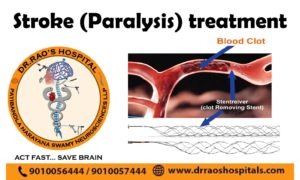
Aneurysms and Haemorrhagic stroke
A brain aneurysm is a weakening or bulging region in the wall of a cerebral artery that cau ses irregular widening or ballooning. There is a chance of rupture and haemorrhagic bleeding due to this weak spot in the artery wall.
When a blood vessel in the brain rupture and bleeds, brain cells and tissues are deprived of oxygen and nutrients, leading to brain damage or death if not treated quickly.
Vascular Malformations
Arteriovenous Malformations (AVMs) are abnormal collections of blood vessels that prevent some tissue from obtaining nutrients during normal blood circulation and cause serious and sometimes fatal strokes.
Looking for the best stroke and cerebrovascular treatment in Guntur and Andhra Pradesh, look no further Dr. Rao’s hospital in Guntur is the best go.
Symptoms of a stroke
The prognosis is much better if you get a quicker diagnosis and stroke and cerebrovascular treatment. That’s why it is crucial to understand and identify the signs and symptoms of a stroke.
Symptoms of a stroke include:
- Dizziness
- Trouble walking
- Loss of coordination and balance
- Difficulty communicating or understanding what others are saying
- Paralysis or numbness in the Face, arm, or leg, mainly on one side of the body
- Blurred vision
- Sudden headache, accompanied by dizziness, nausea, or vomiting
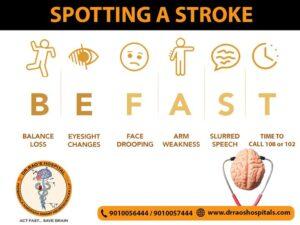
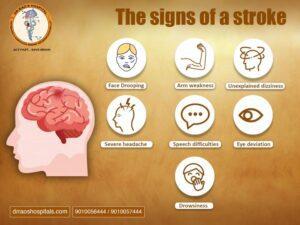
Diagnosis of a stroke
- Blood tests
- Angiogram
- Carotid ultrasound
- CT scan
- MRI scan
- Echocardiogram
- Electrocardiogram
The best Stroke and cerebrovascular treatment in Guntur and Andhra Pradesh
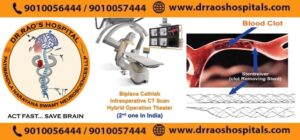
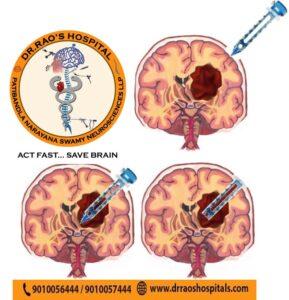
Prevention of a stroke
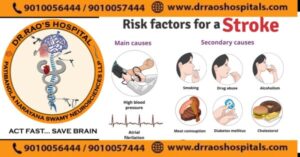 You can reduce the chances of stroke by following these measures:
You can reduce the chances of stroke by following these measures:- Keep your blood pressure in check
- Control diabetes
- Avoid smoking and drinking alcohol
- Maintain a healthy weight
- Exercise regularly
- Eat a balanced diet
